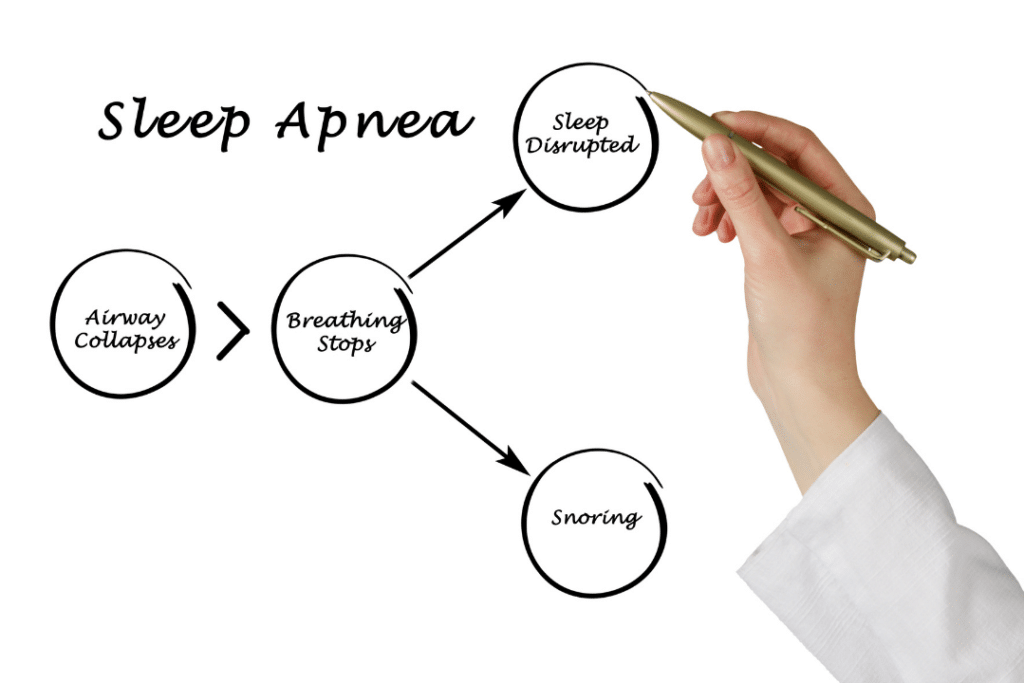|
Getting your Trinity Audio player ready...
|
Overview
Sleep apnea is a serious health condition that causes you to stop breathing during your sleep. Obstructive sleep apnea and central sleep apnea are the two predominant forms of sleep apnea. These can lead to health complications like heart disease, Alzheimer’s disease, and many other problems. Symptoms of sleep apnea include stop and start breathing during sleep, daytime fatigue, frequently waking up, and gasping for air.
Many factors increase your chance of developing sleep apnea like age, obesity, genetics, and being a man (or assigned male at birth). Current treatment options include PAP therapy, mandibular advancement, or surgery.
Table of Contents
Sleep Apnea Causes and Risk Factors
What is Sleep Apnea?
Excessive daytime sleepiness, frequently waking up at night, and having difficulty paying attention are key signs that point towards sleep apnea.
According to the Mayo Clinic, sleep apnea is a sleep disorder where breathing stops and starts throughout the night. Sleep apnea limits how often you breathe and prevents your body and brain from getting enough oxygen while you sleep.
Anyone, even children, can suffer from sleep apnea. Here are some important statistics you should know:
- Approximately 30% of men and 15% of women are reported to have obstructive sleep apnea
- 13% of men and 6% of women aged 30-70 suffer from severe sleep apnea, according to one report.
- Up to 10% % of children (aged 6-15 years) have been estimated to have sleep apnea.
Types of Sleep Apnea
There are two primary types of sleep apnea:
- Obstructive Sleep Apnea
- Central Sleep Apnea
The most common form of sleep apnea is obstructive sleep apnea.
According to a recent review published in Sleep Science, obstructive sleep apnea occurs when your airway is partially or fully blocked when you sleep for 10 seconds or more. Central sleep apnea occurs when the brain is not signaling the body to breathe at regular intervals.
Both central and obstructive sleep apneas can increase your risk of health complications due to low levels of oxygen delivered throughout the body.

Sleep Apnea Complications
According to the Mayo Clinic and the Cleveland Clinic, obstructive sleep apnea or central sleep apnea increase your risk of health problems like:
- Alzheimer’s Disease or other Dementia
- Heart Disease
- Liver Dysfunction
- Chronic Daytime Sleepiness
- High Blood Pressure (also known as hypertension)
- Type 2 Diabetes
- Stroke
- Kidney Disease
- High Cholesterol
- Difficulty Focusing
- Increased Abdominal Fat
These complications are likely because sleep apnea can be a chronic, lifelong condition. There are many symptoms associated with sleep apnea that can lead to the health complications listed above.
Signs of Sleep Apnea
One academic review discusses that both obstructive and central sleep apnea share similar symptoms.
The signs or symptoms of sleep apnea are typically noticed first by a partner that shares a bed with you.
The National Heart, Lung, and Blood Institute reports that the signs of sleep apnea reported by a partner typically include:
- Irregular breathing patterns while sleeping: breathing during sleep stops and starts frequently in people with sleep apnea
- Loud snoring: loud snoring due to obstructive sleep apnea may occur due to obstruction of the airway
- Gasping for air while sleeping: gasping for air while you sleep indicates your body is not getting enough air
Other signs and symptoms of sleep apnea include:
- Chronic daytime sleepiness: this can lead to difficulty focusing and potentially mental health problems
- Frequently waking up at night
- Frequent headaches
- Low libido
- Dry mouth
- Irritability

The National Heart, Lung, and Blood Institute also reports that the signs of sleep apnea in children include:
- Hyperactivity and difficulty focusing
- Frequent bedwetting
- Worsening of asthma-like symptoms
If you notice these signs, consult your health care team. There are several ways to diagnose sleep apnea.
How Sleep Apnea is Diagnosed
After talking with your doctor about your concerns, you may have to undergo sleep tests. The Mayo Clinic reports that two typical sleep tests are used to diagnose sleep apnea:
- Nocturnal Polysomnography
- Home Sleep Tests
Both tests assess your heart rate, breathing patterns, and blood oxygen levels while you sleep. Nocturnal polysomnography tests also look at brain activity as well as arm and leg movements while you sleep.
Sleep Apnea Causes and Risk Factors
What Causes Sleep Apnea?
Obstructive sleep apnea is caused by upper airway collapse while you sleep. According to the Mayo Clinic, the airway collapses in obstructive sleep apnea when the tongue and soft palate muscles in your throat relax.
One report indicates that the airway collapse is more likely if your airway is narrow. Narrow airways can be caused by:
- Craniofacial bony morphology
- Soft tissue deposits around the airway: this can be caused by obesity or enlarged tonsils or adenoids
In contrast with obstructive sleep apnea, a clinical study reports that central sleep apnea occurs when the brain is not sending or receiving the signals it needs. This causes irregular breathing patterns and frequent stops in breathing during sleep.
These irregular signals may be due to extremely high sensitivity of a receptor in the body known as “chemoreceptors,” according to one review. Chemoreceptors are responsible for sending signals to the brain. They detect the level of carbon dioxide in the body. If carbon dioxide levels are high, the chemoreceptors tell the brain to increase how often you breathe.
In central sleep apnea, it is theorized that the chemoreceptors are too sensitive. If your chemoreceptors are too sensitive, they can tell the brain to breathe too much. This could drop the carbon dioxide levels in your body too low. If the carbon dioxide levels are too low, you could stop breathing.

- Access the Sleep Deep Summit
Learn from top leaders in the field the skills you need today.
Obstructive Sleep Apnea Risk Factors
According to the National Heart, Lung, and Blood Institute, obstructive sleep apnea has many factors involved in the development of sleep apnea. These risk factors include:
- Being a Man (or assigned male at birth): it is more common for men to develop sleep apnea than women
- Heart or Kidney Disease: fluid buildup is common with these diseases, and it can collect in the neck and potentially block your airway
- High Alcohol Intake: alcohol has been reported to cause your throat and mouth muscles to relax and cause breathing problems
- Smoking: airways can become inflamed with smoking
- Obesity: excessive fat tissue around the neck can increase the pressure on the airway and cause it to collapse
- Hormonal Imbalance: irregularly high levels of growth hormone and insulin
- Genetics: the shape of your upper airway as well as face and neck structure are partially determined by your genes.
Central Sleep Apnea Risk Factors
The National Heart, Lung, and Blood Institute states that the risk factors for central sleep apnea affect the brain’s ability to control breathing. Factors that can affect this are:
- Diagnosis of heart failure, stroke, amyotrophic lateral sclerosis, or myasthenia gravis
- Age
- Alcohol use or smoking
- Opioid use
- Genetics
How to Treat Sleep Apnea
There are many treatments available for sleep apnea ranging from devices to lifestyle modifications.
Medical Treatments for Obstructive Sleep Apnea
The best, non-surgical way to treat obstructive sleep apnea is to use continuous positive airway pressure. This is more commonly known as CPAP. CPAP machines use pressurized air to gently hold your airway open so you can breathe. Air is directed from the machine to your airway using tubing connected to a mask worn at the nose or over the nose and mouth. This pressure prevents your airway from collapsing. There are many CPAP masks available, and it may take time to find one that fits or is comfortable.
Oral devices can also be used, but these are more likely used for mild cases of obstructive sleep apnea. These move your jaw forward so your throat opens more.
Surgeries for Sleep Apnea
Sleep apnea surgery is another treatment option. According to the Mayo Clinic, surgeries for sleep apnea include:
- Repositioning of the Jaw: this sleep apnea procedure brings the jaw forward to increase the size of the airway
- Implants: sleep apnea implants are a new treatment option.
- Reducing the Size of Throat Tissue: there are multiple surgeries that removes excess tissue from the throat to allow the airway to become wider.
- Creating a New Airway (also known as a tracheostomy): this sleep apnea surgery is used for severe sleep apnea when all other forms of treatments fail. This sleep apnea procedure creates a permanent hole in the neck to increase airflow.
Medical Treatments for Central Sleep Apnea
Central sleep apnea requires different treatment than obstructive sleep apnea.
Medication changes may also be required because some medicines can cause breathing problems.

Lifestyle Modifications to Treat Sleep Apnea
There are several ways that you can change your lifestyle to improve your life with sleep apnea.
One systematic review reports two key lifestyle changes can improve sleep apnea:
- Weight Loss
- Exercise
One study reports that weight loss reduces the volume of the tissues surrounding the airway. This reduces the amount of tissue that could block your airway.
Exercise is commonly studied for its effects on weight loss. However, one report states that exercise also improves lung function.
Quitting smoking and eliminating alcohol intake are also recommended to improve both central sleep apnea and obstructive sleep apnea. Doing so can reduce inflammation and eliminate their impact on your brain’s control of breathing.
You can learn more about how to treat sleep apnea at the Sleep Deep Summit hosted by Audrey Wells, MD. At this summit, you will discover unique treatments that could help you get the rest you need and deserve.
Sleep Apnea Videos
The Benefits Of Good Sleep For Alzheimer’s Disease
How To Breathe, Sleep, Focus, & Concentrate To Destress
Glymphatic System, Lymphatic System And Mental Health

References
Mayo Clinic. (2020). Sleep apnea – Symptoms and causes. Mayo Clinic. Read it here.
Peppard, P. E., Young, T., Barnet, J. H., Palta, M., Hagen, E. W., & Hla, K. M. (2013). Increased prevalence of sleep-disordered breathing in adults. American journal of epidemiology, 177(9), 1006–1014. Read it here.
Tsukada, E., Kitamura, S., Enomoto, M., Moriwaki, A., Kamio, Y., Asada, T., Arai, T., & Mishima, K. (2018). Prevalence of childhood obstructive sleep apnea syndrome and its role in daytime sleepiness. PloS one, 13(10), e0204409. Read it here.
Abbasi, A., Gupta, S. S., Sabharwal, N., Meghrajani, V., Sharma, S., Kamholz, S., & Kupfer, Y. (2021). A comprehensive review of obstructive sleep apnea. Sleep science (Sao Paulo, Brazil), 14(2), 142–154. Read it here.
National Heart, Lung, and Blood Institute. (2022, March 24). Sleep Apnea – What Is Sleep Apnea? | NHLBI, NIH. Read it here.
Cleveland Clinic. (2020). Sleep Apnea. Cleveland Clinic. Read it here.
Mayo Clinic. (2018). Sleep apnea – Diagnosis and treatment. Mayoclinic.org. Read it here.
McNicholas, W. T., & Pevernagie, D. (2022). Obstructive sleep apnea: transition from pathophysiology to an integrative disease model. Journal of sleep research, 31(4), e13616. Read it here.
Eckert, D. J., Jordan, A. S., Merchia, P., & Malhotra, A. (2007). Central sleep apnea: Pathophysiology and treatment. Chest, 131(2), 595–607. Read it here.
Strollo, P. J., Jr, Soose, R. J., Maurer, J. T., de Vries, N., Cornelius, J., Froymovich, O., Hanson, R. D., Padhya, T. A., Steward, D. L., Gillespie, M. B., Woodson, B. T., Van de Heyning, P. H., Goetting, M. G., Vanderveken, O. M., Feldman, N., Knaack, L., Strohl, K. P., & STAR Trial Group (2014). Upper-airway stimulation for obstructive sleep apnea. The New England journal of medicine, 370(2), 139–149. Read it here.
Carneiro-Barrera, A., Díaz-Román, A., Guillén-Riquelme, A., & Buela-Casal, G. (2019). Weight loss and lifestyle interventions for obstructive sleep apnoea in adults: Systematic review and meta-analysis. Obesity reviews: an official journal of the International Association for the Study of Obesity, 20(5), 750–762. Read it here.
Wang, S. H., Keenan, B. T., Wiemken, A., Zang, Y., Staley, B., Sarwer, D. B., Torigian, D. A., Williams, N., Pack, A. I., & Schwab, R. J. (2020). Effect of Weight Loss on Upper Airway Anatomy and the Apnea-Hypopnea Index. The Importance of Tongue Fat. American journal of respiratory and critical care medicine, 201(6), 718–727. Read it here.
Kline, C. E., Crowley, E. P., Ewing, G. B., Burch, J. B., Blair, S. N., Durstine, J. L., Davis, J. M., & Youngstedt, S. D. (2011). The effect of exercise training on obstructive sleep apnea and sleep quality: a randomized controlled trial. Sleep, 34(12), 1631–1640. Read it here.
Kline, L.R. (2023). Clinical presentation and diagnosis of obstructive sleep apnea in adults. UpToDate. Read it here.





